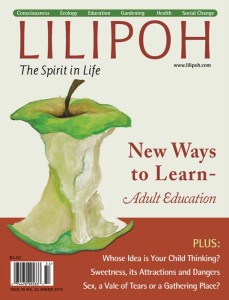Whose Idea Is Your Child Thinking?
 By Nancy Blanning
By Nancy Blanning
The Effects of Media on Your Child’s Context for Life
It is our fondest hope as parents and teachers that our children will be allowed to encounter the world directly through the freshness and unprejudiced vision of their own eyes, ears, and hands. I think of our grandson’s dedication to snail-watching last spring and summer. Nothing was more interesting to him. And through his devotion to watching these small creatures, he began to form his own personal image of “snail-ness.” Another child has a special attentiveness to sounds: bird song, bug buzz, and the carefully articulated speech in nursery rhymes that invite her interest in the spoken word. She loves to sing and echoes back the simple, sweet sounds of her mother’s voice. At the very beginning of life, touching (and, of course, tasting) are the avenues for learning about the world. This begins with the warmth of the parent’s nestling chest, the sweet taste of milk. Then the child learns so much about the texture and character of different materials: wood with its slivers and splinters, pine cones with their pungent smell and rough surface, and the softness of the favorite blanket that one cannot sleep without. These are all firsthand experiences and they resonate deeply into the child.
We want these impressions to be good ones. We know that first impressions are often lasting ones. The first time we experience something, we tend to assume that this is what a particular experience is like. How things are portrayed makes a huge impression upon us, especially on young children. Rudolf Steiner, the founder of Waldorf education, described young children as “total sense organ[s].” The little child has no filters and no capacity to discriminate as adults are able to do through years of experience; and to know if something is desirable and true or untrue. Little children accept all experiences equally. They are quite defenseless.
These simple experiences are available to our children, but it is getting harder and harder to find them in unadulterated or unexaggerated form. Children and adults alike are bombarded with media imaginations of how the originator of the video, toy, song, or advertising piece wants us to view the product. These products are usually loud, with stylized speech, stereotyped with unrealistic and distorted body parts and facial features. They show exaggerated behavior, louder, faster, and more clever and slick than we know real people to be; and more importantly, than we want our children to be. These impressions are taken in deeply where they lodge in the child’s memory collection of “this is what the world is like.”
There are many good reasons to reduce children’s screen time and other media exposure. Without the distraction of media, children have richer opportunity for free, creative play; for exploration of the world; for developing social play with others; for developing healthy sensory systems through lots of unstructured movement; for helping with practical life in the home to learn how real people live their lives. In these ways, children can experience life actively rather than by passively sitting and taking in someone else’s ideas of the world.
As a Waldorf educator I have shared all of these points with families over many years. But recently it has struck me strongly that a most compelling reason to shelter our children from media is to protect them from other people’s representations of the world that we know are not true. These impressions are difficult to erase. Waldorf education is all about supporting the development of free and independent thinkers, who have the capacity to chart their own course in the world. Our media-dominated society is working hard to saturate our minds with ideas of how they would like us to think about the world. Speaking personally, I do not want these people (whose motives probably have more to do with profit than the welfare of our children) to form the children’s view of the world and their view of human relationships. The next time you consider letting your child see media, please ponder: Whose idea will my child be thinking? Does it have worth that will guide my child well in life? Will it add to the foundation upon which an upright life can grow?
There are so many things in life we cannot control. Our children’s media exposure is something we can.
Nancy Blanning has been a Waldorf early childhood educator for nearly thirty years, emphasizing therapeutic and developmental support with young children. She also serves on the board of the Waldorf Early Childhood Association (WECAN) and is co-author with Laurie Clark of Movement Journeys and Circle Adventures, a therapeutic movement resource book for teachers.
